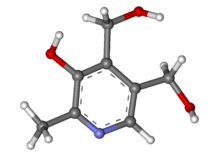Pyridoxine
Appearance

| |

| |
| Names | |
|---|---|
| IUPAC name
4,5-Bis(hydroxymethyl)-2-methylpyridin-3-ol
| |
| Identifiers | |
3D model (JSmol)
|
|
| ChEBI | |
| ChEMBL | |
| ChemSpider | |
| DrugBank | |
| ECHA InfoCard | 100.000.548 |
| KEGG | |
| UNII | |
CompTox Dashboard (EPA)
|
|
| |
| |
| Properties | |
| C8H11NO3 | |
| Molar mass | 169.180 g·mol−1 |
| Melting point | 159 to 162 °C (318 to 324 °F; 432 to 435 K) |
| Pharmacology | |
| A11HA02 (WHO) | |
Except where otherwise noted, data are given for materials in their standard state (at 25 °C [77 °F], 100 kPa).
| |
Pyridoxine (also called pyridoxol,[2] not to be confused with pyridoxal) is one form of vitamin B6. Its hydrochloride salt, pyridoxine hydrochloride, is used as a vitamin B6 dietary supplement.
References
- ^ Pyridoxine at Sigma-Aldrich
- ^ p. 11, B Vitamins and Folate: Chemistry, Analysis, Function and Effects, Victor R. Preedy, ed., Royal Society of Chemistry, 2012, ISBN 978-1-84973-369-4; series Food and nutritional components in focus, #4.
